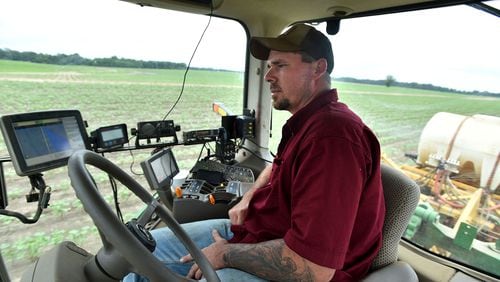Top 10 Georgia agriculture commodities in 2014
1. Broilers (poultry), $4.5 billion
2. Beef, $1.1 billion
3. Cotton, $965 million
4. Eggs, $823 million
5. Timber, $602 million
6. Peanuts, $564 million
7. Dairy, $438 million
8. Blueberries, $335 million
9. Horses, $333 million
10. Pecans, $313 million
Source: University of Georgia.
Lee Cromley, by all outward appearances, exudes the end-of-season satisfaction of yet another successful cotton crop.
The last of his 2,000 acres was recently picked. The gin he co-owns with other Bulloch County farmers runs 24/7. The football-field long warehouse is filled with 500-pound bales stacked eight high. Some post-harvest rest awaits.
Cromley, though, isn’t satisfied. Cotton at 65 cents a pound — one-third the 2011 price — will do that to the most successful of farmers. Georgia growers expected to harvest only 1.1 million acres of cotton last year, the lowest amount since 1994 except for the recent recession years. In all, production was off about 11 percent in 2015 compared to 2014.
Nationwide, cotton production is nearly 20 percent less than 2014, according to the U.S. Department of Agriculture. Not since Ronald Reagan was in the White House has the country produced so few bales, except between 2007-09.
Here in Bulloch, the No. 5 cotton county in Georgia, farmers planted only 40,000 acres last year, down 20 percent from the previous year. Statewide, the crop’s total value dipped below $1 billion and — worse — lost its designation as the state’s No. 2 money crop to beef. Poultry is far and away No. 1.
“It’s unbelievable what’s happening to cotton,” said Cromley, a fifth generation farmer. “But you have to ride out the hard times. At some point some folks can’t ride it out anymore. The outlook is not very good.”
Cromley, like ag economists and extension agents, blames China. And Brazil. And Congress. And — the biggest threat — the world’s newfound preference for polyester.
Yes, polyester. Khakis and Dockers are out. Leisure and athletic wear — Lululemon yoga pants anyone? — are in. And the huge drop in oil prices over the last 18 months contributes to the popularity of oil-based synthetic fibers.
In 2000, consumers liked cotton as much as polyester and bought 20 million tons of each fiber, according to PCI Fibres, a British consultancy. Last year, they bought 31 million tons of cotton — and 46 million tons of polyester.
Making cotton cool
“The apparel industry has come up with a lot of things that are not made of cotton that consumers like,” said Don Shurley, the University of Georgia’s cotton economist. “Part of the challenge for the cotton industry, in terms of turning this around, is to try and find ways to make cotton more desirable for consumers. It seems the man-made fiber industry has done that.”
As with most global commodities, China dictates the market. Leisure suits, apparently, are big in the People’s Republic. China, according to PCI Fibres, accounts for nearly 70 percent of the world’s polyester production. And the Communists are also sitting on millions of bales of cotton, further depressing prices and U.S. farmers bank accounts.
China went on a cotton-buying spree in 2011, gobbling up 50 million bales or more — about half the world’s consumption — and storing them for its textile industry. Prices hovered around $2 per pound for upland cotton at the beginning of the splurge, but quickly fell. Five years later, with millions of bales stuck in warehouses, there’s little demand for Georgia’s cotton.
“They got off the market and they’re not buying any anymore,” said Cromley, 57, a Georgia Cotton Commission board member. “That’s a big part of why we are where we are today. Our exports have gone way down.”
In years past, farmers like Cromley could turn a bad crop or shrug off low exports knowing that Uncle Sam would bail them out. Between 1995 and 2012, according to the Environmental Working Group, cotton farmers received $33 billion in federal subsidies — money that all but guaranteed farmers would earn a profit regardless of market pressures.
Brazil, though, sued the United States claiming the subsides were, in the words of the World Trade Organization, “trade-distorting” and gave U.S. growers an unfair advantage. The WTO agreed and the current farm bill cut some of the subsidy programs that totaled nearly $600 million in fiscal 2013, according to the Congressional Budget Office.
No safety net
“In years past, when prices were as bad as this one, the farm bill offered us a chance to break even,” Cromley said. “We lost that safety net. We lost the ability to break even.”
Cotton farmers still receive subsidies from Washington, said UGA’s Shurley, just not as much and without a 100 percent guarantee. The farm bill may steer cotton farmers to other, higher subsidized crops. Cotton farmers typically rotate between cotton, peanuts and corn.
Bill Tyson, UGA’s extension agent in Bulloch County, said peanut acreage was up 30 percent in 2015 in Bulloch. Statewide, nearly 800,000 acres of peanuts were planted last year, up 200,000 acres from the previous year.
Most Georgia cotton farmers, though, aren’t ready to quit cotton. They’ll rotate a field to peanuts every three of four years, but cotton is — was — the big money crop. Besides, most farmers can’t afford to quit cotton. Cromley’s six-row John Deere picker costs as much as a house in Buckhead. The cotton gin he co-owns can’t process soybeans. And his banker would frown upon a shift to organic vegetables.
“Most people are going to have to try and make it through another year or two and hope prices turn around,” said Cromley, amid a beautiful field bursting with white bolls awaiting the picker. “There are always ups and downs and periods where it looks bleak. But we’ve always come out of it before.”






